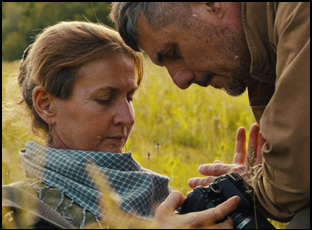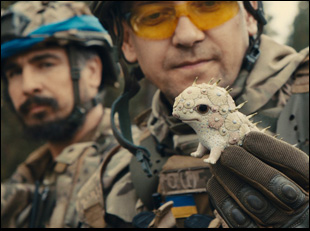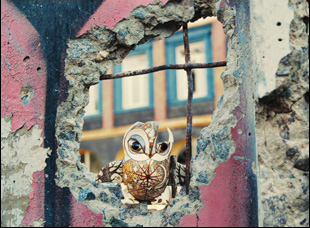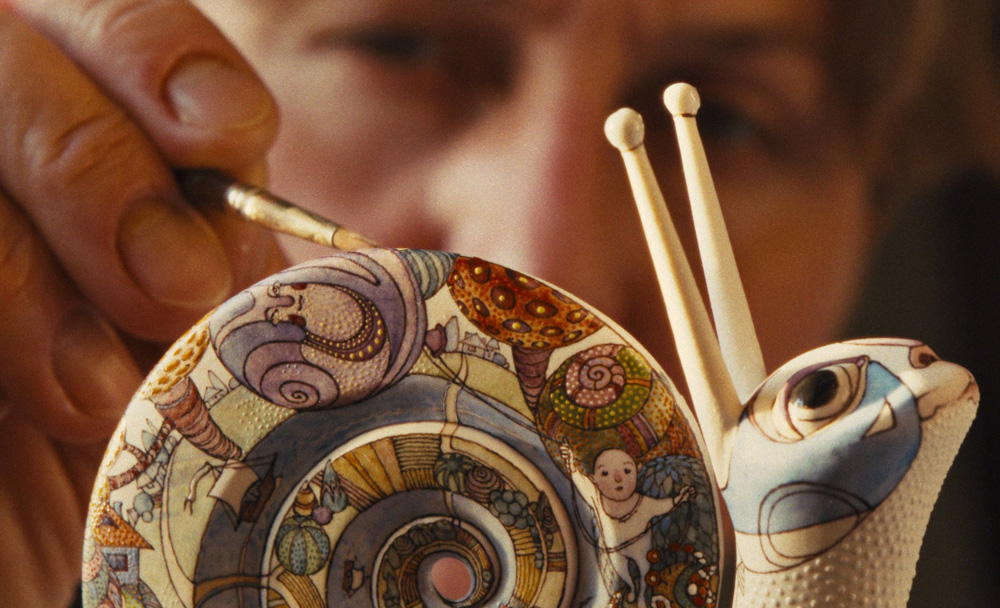Although the filmmakers behind “Porcelain War” answered the most pressing question before them immediately — that of what they could do upon the Russia invasion into Ukraine in the winter of 2022 when so many felt helpless — there were many more as Brendan Bellomo, based in Los Angeles, and Slava Leontyev, based in Kharkiv, began working together on a film, set up by mutual friends, though the two didn’t speak the same language. It wasn’t only a communication barrier that Bellomo would have to overcome when Leontyev, as well as his friend Andrey Stefanov, would have to capture the war unfolding in front of them and were used to far less cumbersome tools to make their art, more comfortable with a paintbrush and easel than a camera. However, while Bellomo could easily impart the basics of the technology, he was pleased to discover that the things he could never teach were what already came naturally to his collaborators and subjects.
“Slava and Andrey had such deep, deep concepts of composition and lighting that I was really impassioned to share with them this notion of camera movement or frame size — these things that they could kind of use with their artistic instincts,” Bellomo recalled recently. “It was just a joy because Andrey was like, ‘Oh, look at this particular color of painting [for this kind of scene] and Slava would say, ‘What if we go not at 7.30 p.m. but at 8 p.m. to film this and the light is exactly like this?’”
The idea that there is any beauty amidst in the ongoing war in Ukraine may be confounding, but “Porcelain War” is positively luminous when it comes to reflecting the resilience of those holding their ground in the country under siege, centered on Leontyev and his wife Anja Stasenko, who long populated their natural surroundings with ornate porcelain figurines intended to stand the test of time. Bellomo was intrigued to potentially make a film about that alone, but after the Russian invasion, the art took on a new dimension as it remained in areas that were being summarily reduced to rubble and Leontyev was obliged to take up arms as part of the Ukrainian resistance. He may train fellow soldiers in his platoon, nicknamed Saigon, on how to use their guns, but the camera that he ends up arming all of them with proves to be perhaps even more powerful, collecting evidence of ongoing atrocities, but also their refusal to be cowed by the threats Russia poses to their way of life, holding onto the traditions that have long been a source of strength and expressing themselves boisterously in what ways they can.
A propulsive score from the Kyiv folk rock quartet Dakhabrakha underlines the infectious vitality of “Porcelain War,” in which Anya and Slava defy their circumstances by continuing to create art in the face of destruction, placing figurines in heavily hit war zones, and Andrey puts his energy towards painting to take his mind off of being separated from his wife and young daughters. With their sensitivity assumed, the film offers an unusual portrayal of artists as fighters, depicting them as actively engaged on multiple fronts in staving off immediate danger of eluding landmines and bombs and keeping their imagination up to avoid the potential devastation of having their spirit broken. After winning the Grand Jury Prize for documentary earlier this year at Sundance, “Porcelain War” is now making its way into theaters and Bellomo and Leontyev spoke about how they came to partner on the powerful film, forging a line of communication rooted in art and how it’s already helped bring people together in a common cause.

Brendan Bellomo: One of our producers grew up under Russian oppression in communist Poland and she discovered Anya and Slava’s art about eight years ago. She was so moved by it because it really reminded her of home. The four of us were actually beginning to work on an animation together and then Russia invaded. I called up Slava to see if he was okay, and he said, “We’re going to stay, we’ll keep making art at night.” And I asked “Why, what are you doing during the day?” And he told me “I’m in the Ukrainian special forces and I’m teaching civilians how to defend their families,” and in this moment, we realized there were two forms of resistance happening — one of them artistic and another one peaceful people feeling they had no other choice but to take up arms. Slava felt this was a story that you really weren’t seeing in the news — a story told through Ukrainian perspective of everyday people, of artists who were still there — so I really wanted to empower them to share this with the world.
Slava Leontyev: Never before I thought about filming, but when Brendan started to speak about this, I understood how amazing is this opportunity to share our experience. Not news footage, but to share our personal experience as artists and soldiers. It was something really new, but we never had enough time to study how to fight or how to film or how to speak English, we just we were forced to do this. In this situation, we must be really fast and it was easy because Brendan sent to us not only cameras, but incredible video tutorials.
Brendan Bellomo: We figured out a way to send cameras through a paramilitary supply chain that was bringing in medical aid through Poland and we had a volunteer — a Ukrainian woman who’s a hairdresser from New Jersey that was bringing 50 bags of medical supplies at once — who said, “I’ll bring your cameras.” And when this first camera body arrived in Kharkiv, we had an enormous challenge because at the time we were separated by 6,000 miles, Slava’s English is excellent now, but at the time he didn’t really speak even a word and we were coming from these two different cultures. I was like, “How are we going to do this?” I asked Anya how she was feeling in the first days of the war and she said to me, “We’re so alone here, we feel like we’re on the moon.” This reminded me of the Apollo spacecraft when it was failing in outer space. It had a duplicate of every piece of equipment back on the ground in Houston, so every time I sent a lens or a camera or a microphone I had the same thing here in Los Angeles that I could hold that in my hands and I could say to Slava and our cinematographer Andrey, “This is how you take your artistic instincts as a painter, as a sculptor and translate them into cinema.” We worked together over Zoom with an interpreter and we created almost an impromptu film school for them to be able to figure out how they could tell the story of what their lives had transformed into.
Slava Leontyev: We just picked up our cameras and started to film, but I was serving in Ukrainian army at that time and I was able to work on “Porcelain War” only because my unit completely supported us. They trusted us and they [also] thought it’s an unbelievable opportunity to share our experience and we must to do this. Literally when I picked up my camera, someone picked up a weapon in my place and fought instead of me. We understood we had a [base of operations] in Los Angeles and we were never worried about next stage of the work, but we felt [as] people on the ground, we are the eyes of our project and we looked around very attentively and tried to find beauty and bring hope and inspiration from this horrible experience because all war looks the same. It was for us much more important to show what may be destroyed. The main target of this aggression was our culture and our identity, so we focused on beauty of our nature and our culture, and especially the beauty of people who defend all of these important things and this freedom how to think and how to create.

Brendan Bellomo: We were working with an interpreter at first, so I would speak and they would translate, Slava would listen and then speak. But it was very, very frustrating and at the same time once I heard what Slava was saying in reaction to what I was saying, I realized “God, he’s thinking almost the same thing” and while the interpreter was translating, I started making little drawings. So Slava would have pens that we would hold these up to the screen [and draw] these messages and all of a sudden we’re like, “Oh yeah, we get it,” so these became storyboards. Those then became blocking diagrams of how cameras could move and just different ideas on how to react [in certain situations]. They couldn’t predict the turn of their life one day or another. One day they would be creating art, the next they would be trying to go somewhere to pick mushrooms and they would encounter a field of landmines. The next they would be on a mission and at the same time as artists, they were all looking for ways to make sense of what’s happening around them. We really had a very rich, close collaboration despite the distance and we were fluent in the same language. Visual art is completely universal, so that really made us feel that there wasn’t a language barrier after all.
And when Slava and Anja were [on the ground], I said to Slava, “Do you could know anybody who could just point the camera and press the button?” so they could be in frame. He says, “Well, I do know somebody. Let me send you something and he sends this folder of photographs of absolutely stunning oil paintings and landscapes [from his friend Andrey]. I said, “This is already a cinematographer, you just need to show him how to become a camera operator. He understands how to tell a story with images.” So we sent 15 camera bodies to Andrey and Slava and members of [their platoon] Saigon, and lesson one was how do you turn on the camera and by the end of the film, they shot over 500 hours of footage. And Andrey pushes himself to just go and learn everything. He’s a total perfectionist and he experiments too, he’s always off in the corner doing something and it’s magic, so Slava couldn’t stop him actually.
Slava Leontyev: Andrey is really a perfectionist and for my first question, “Are you ready to film us?” He answered, “I’m not ready.” And I say, okay, “Andrey, you are not ready today, but tomorrow we will start” and his first frame was completely successful. This frame is in our movie. From the very beginning, he was perfect.

Slava Leontyev: It’s an absolutely unbelievable achievement of Brandon to assemble all these different kinds of footage. We just filmed a lot. Also we have animation that Anja created, especially these three painted figurines. She painted a very complicated story and this story of one figurine is about our peaceful past in Crimea, the second is about our present in war and the third is about our dreams for the future. These paintings were animated and it gave us language to speak about the terrors of war without showing them like news does because news gets old quickly. But beauty never does, so we focused on that.
Brendan Bellomo: The animations give us this very strong structure and this was unusual in that in an ideal scenario, you get all the footage and then you would edit. But we were looking to follow Anja and Slava’s lives, so as they would film, we would always cut and the shifting unpredictability of their lives was counterbalanced with how they have such an incredible story as people. Anja and Slava knew each other since they were very young. They fell in love, they were working together, and their collaboration is this constant running through this tumultuous present that they’re dealing with, so we’re interweaving [this history and animation] together and then traveling between Anja and Slava’s story, the really heartbreaking and courageous story of Andrey as a father dealing with bringing his wife and daughters to safety, and then of course, Saigon, the unit, so we have multiple characters and multiple storylines.
The edit was something where we really worked from a very intuitive standpoint. My co-editor Aniela Sidorska and I have our own unspoken language — we’re husband and wife as well, so there was kind of a parallel with Anja and Slava and so for us to be able to work at this speed and this difficulty, it’s not all about conversation. It’s like one person has an idea and you complete the next person’s sentence, so we were doing this in the same room, but we were also doing this between two countries 6,000 miles away. That was how we did it. It’s really an intuition and it’s a very, very musical the way that we try to work.

Brendan Bellomo: Well, I was asking Slava, is there any music that you guys love? And he said, “There’s a band that is famous in Ukraine because it really represents this Ukrainian spirit. The music has this huge range of emotion, it’s deep sadness and lamentation and the soaring joy.” He sent me “Vesta,” this opening song in the film and I never heard anything like it. I thought, “Wow, this has a very distinct rhythm to it. It’s driving, but it’s really soulful. It’s very universal and even if you don’t understand the lyrics when it’s a native language music, it cuts across culture.” They were so vulnerable in the way they sing and speak and I began to cut one scene and another. All of a sudden, the entire rough cut to the film was all Dhakabraka and we reached out to them and said, “We would really love to use your music to the film. Meanwhile, I’m thinking “What if they say no”? But lo and behold, they said, not only do we want to support you guys, but here’s our entire catalog of music. We’re supporting, with the proceeds of our concerts, musicians who are fighting” and they’re absolutely amazing people. So this became really the heartbeat of the film and as we edited, it really dictated the rhythm of how the story unfolds for the audience.
What’s it been like engaging with audiences as this film gets out into the world?
Brendan Bellomo: First and foremost, it’s been absolutely incredible because audiences have been deeply moved by the film. Ukrainian audiences that have seen it have said this more than anything else we’ve seen really feels like our experience. And Slava’s been to Washington four times now with the film and we’ve had the distinct honor of sharing it at the U.S. Capitol for Congress and this story occurs within the borders of Ukraine, but it’s about all of us. It’s about hope. It’s about our ability to put good back into the world, no matter how dark things may seem. And at the same time, the outcome of this war affects so many more people in the world than just Ukraine. You have other authoritarian nations that are looking at the outcome here. If Russia wins, it could embolden China to attack Taiwan and there’s resounding implications because democracy really is under threat now, so the reactions have been very strong because people realize the Ukrainian people are fighting for freedom all around the world.
Slava Leontyev: I hope “Porcelain War” brings inspiration and because it’s a story of success. It’s a story about regular civilian people who are ready and who are able to defend democracy and preserve their humanity, even in darkest of times.
“Porcelain War” is now open in New York at the IFC Center and opens on November 29th in Los Angeles at the Monica Film Center. A full list of theaters and dates is here.




